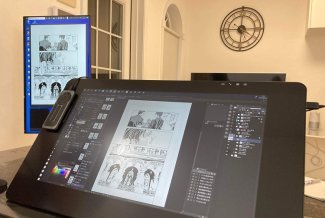People in central London sit on one of a number of ‘Camden Benches’ dotted around the city. It is what artist Stuart Semple calls a “textbook example” of “hostile design”.
When US$20,000 worth of studs were installed on the surface of a fountain in a downtown Toronto park in 2017, the upset felt by some locals was tempered by a general acceptance that the measure – designed to prevent damage caused by skateboarders – was necessary.
The studs weren’t overtly antagonistic – at least not compared to the inch-high steel spikes placed outside a London grocery store to prevent homeless people from sleeping there. But they are still what Cara Chellew, a Toronto-based researcher and public space advocate, calls ‘hostile architecture’.
This trend, of trying to control behaviour and prevent crime through environmental design, isn’t new. But it’s certainly gaining traction in cities and towns all over the world.
“We’ve been using a form of defensive architecture for as long as we’ve had cities,” says Chellew. “But it’s really ramped up in the last 15 years or so since there’s been an increased focus on public space in city building,” she tells Equal Times. “We’re creating public spaces but within public spaces there is the intention to keep public space orderly and maintained, to save on policing costs, or to reduce maintenance and vandalism.”
One infamous example is London’s ‘Camden Benches’, what British artist Stuart Semple, who’s been waging a campaign on “inhumane, anti-human designs in public spaces” through his work, describes as a “textbook example” of unpleasant design.
On a sunny day people can sit on the slightly slanted concrete benches, which were first installed in central London by Camden Council in 2012, while they’re having lunch, waiting for friends or simply passing the time. But they make skateboarding, rough sleeping or even sitting for any length of time very difficult.
The impact of this type of architecture includes traditional benches with a middle centre bar to more extreme forms like ledges in doorways, or as Chellew has seen, broken glass embedded in concrete to keep people from scaling a wall. It looks aesthetically unpleasant. But its effect goes beyond that.
Hostile design is usually targeted at the homeless, but it negatively impacts the elderly, pregnant women and disabled people. And its consequences are felt by all: “You end up saying ‘This place is a bit edgy’ or ‘This place must be a bit risky’. You’re not going to stop and talk to people. And this fear starts to percolate in a public space,” says Semple.
A response to rising street homelessness
Defensive architecture is particularly prevalent in major global cities where neoliberal policies have taken hold, correlating with the rise of homelessness after the 2008 financial crisis. According to research published in late 2016 by the UK homeless charity Crisis, 60 per cent of people using homeless services in England and Wales reported an increase in seeing the kind of defensive architecture that made sitting or lying down in public impossible. A spokesperson for the mayor of London Sadiq Khan tells Equal Times that he believes this rise is a “national disgrace” and that the mayor “opposes inhumane types of defensive architecture such as anti-homeless spikes”.
Proponents of hostile architecture argue that it is needed for public safety, and Chellew says it is becoming more widespread as designers and urban planners start to think of it as “a form of best practice. This idea gets perpetuated among the design community that this is a way that we could be designing space that is lower cost, that is supposedly accessible to everyone.”
Hostile design may also be on the increase in the Global South. Sharp metal spikes that a HDFC Bank branch in Mumbai placed outside the building to warn off street vendors and rough sleepers were removed last year after locals expressed their outrage on Twitter.
In Cape Town, the Iziko Social History Centre, which is home to a number of important cultural artefacts, has glass panels between its heritage arches so that people cannot sleep or loiter in the gaps behind and below the arches.
Other public institutions in South Africa have similar features, as well as pavements with pointy rocks to prevent sleeping. With high crime rates in cities like Johannesburg and Cape Town, and income inequality felt across the country, the issue of hostile design can become more complex.
Perceptions of crime often drive responses to crime, with the safest areas of cities often having the most preventative (read: hostile) measures, says Rashiq Fataar, the founding director of Our Future Cities, a Cape Town-based non-profit working on ways to make cities more equitable and socially inclusive.
Hostile design, he says, often has the intention of creating more secure spaces which require less maintenance – but in most cases it has the opposite effect. “Sustainable security and safety are always only ever achieved by good urban design, with involvement from the community and stakeholders and what we call passive surveillance: this means people on the streets and not just through keeping people out by design,” says Fataar.
As the world’s most unequal nation, and where the afterlife of apartheid still impacts every facet of society, Fataar says more needs to be done to encourage and welcome people to sit, linger, and enjoy spaces without having to spend money buying a coffee or going to a restaurant.
Reclaiming public space
So how can we reclaim public space? One way is to challenge planners, architects and designers directly about how they’re designing public spaces. Chellew, for example, has raised the use of defensive architecture with the City of Toronto.
When Equal Times spoke to a City of Toronto spokesperson about the studs that were added to the Berczy Park fountain she said it was introduced following an incident where a statue was extensively damaged by skateboarders, resulting in costly repairs. “Sometimes design elements like these are required to protect the amenity. Keeping our public spaces in good working order is important to ensure they remain, open, inviting and safe for everyone.”
Meanwhile, a spokesperson for London’s Camden Council said that the ‘Camden Benches’ had actually been “designed to reduce graffiti, flyposting and littering”, and that the council had introduced a number of measures to “provide [homeless] individuals with effective routes off the streets”. This includes a specialist outreach team for rough sleepers and an app to offer advice and support for people experiencing street homelessness.
Regulations in privately-owned but publicly-accessible spaces could be another measure, while community consultation is a way to create more access to public spaces. In Toronto, Chellew recently created the #DefensiveTO mapping project, recruiting over 50 volunteers to take photos of defensive architecture alongside her. It was inspired by the Hidden Hostility DC and #SoyonsHumains (“Let’s Be Human” in French) campaigns which both involved the creation of interactive maps to highlight geolocalised tweets.
Semple, who became “horrified” after seeing metal bars placed on benches in his hometown of Bournemouth last year, launched hostiledesign.org soon after. It has a database of photographic examples of hostile architecture from around the world, which the artist encourages people to share using the hashtag #HostileDesign to “name and shame” the people behind it.
So far, through the site, over 500 examples of defensive design have been tagged on Instagram. Meanwhile nearly 2,000 ‘design crime’ stickers, which can be placed directly onto objects of hostile design, have been disseminated through the site.
But both Chellew and Semple say that the most successful advocacy against defensive architecture can be achieved through media attention. In Toronto last year, a group of people, including Chellew, called for the removal of a defensive grate covering on a heating vent that people used to sleep on at a health organisation which oversees several hospitals. After it made news headlines, the grate was removed. Similarly, within 24 hours of Semple posting a photo of the bars on the chairs in Bournemouth on his Facebook page, it was viewed more than a million times. Just a week later, the local council removed them.










